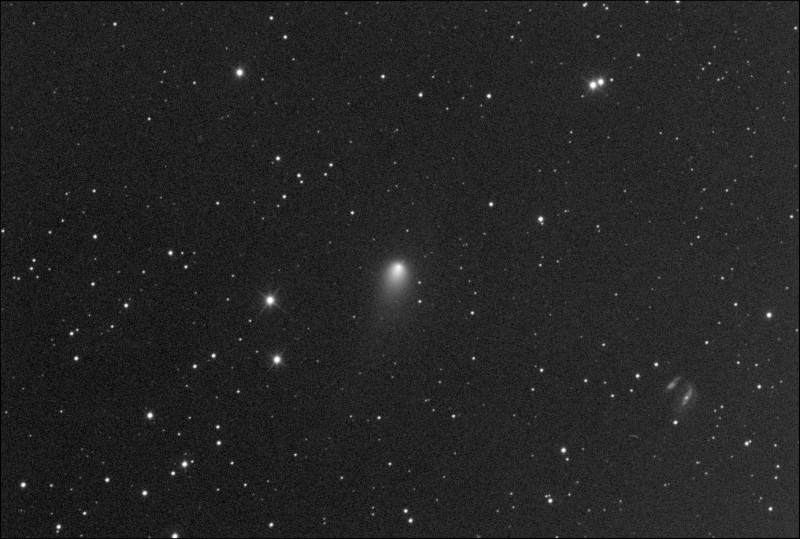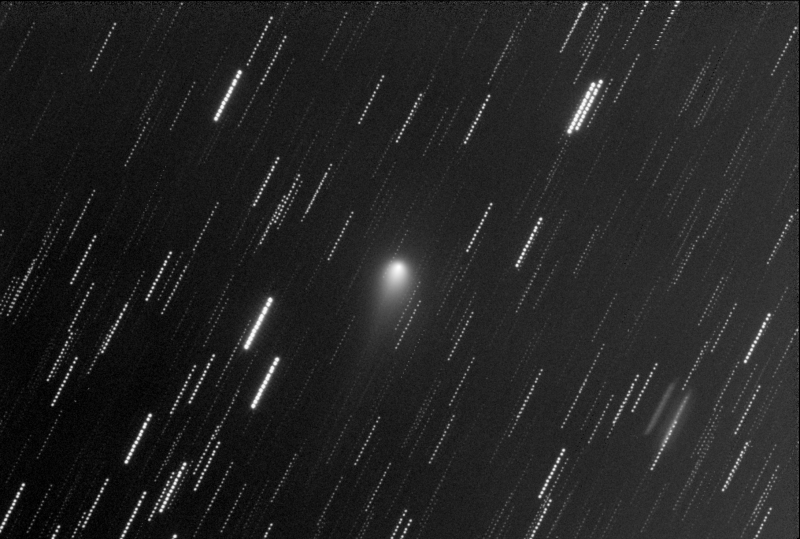
These travelling masses of ice and dust galloping throughout the universe are believed to have shaped the course of life
on this planet. As a result of comet-hunting, many deep-sky objects including nebulae and galaxies have been discovered
with perhaps the most obvious collection being the 109 (or 110) DSO's attributed to Charles Messier. With over 1000 comets
now having been catalogued and approximately 200 having been established as being periodic, historical records suggest
comets to have been observed and documented as far back as 240 BC (Comet Halley by the Chinese).
Comets are appealing to amateurs for a variety of reasons: they lead to incredible photographs thanks to their glowing and
colourful tails extending millions of kilometers as they approach the sun and the ice and various frozen gases in the nucleus
begin to vaporize; they are the precursors of meteor showers as remnants left behind on prior visits are encountered by our
planet while we orbit the sun; and they represent an active adventure and form the basis of a "culture" (comet hunters) based
on the discovery of new comets during the early dawn hours on the eastern horizon or just after sunset on the western horizon.
Note: Comet 168/P Hergenrother illustrated below while passing through the Great Square of Pegasus
was discovered on November 22, 1998 by American astronomer Carl W. Hergenrother using the facilities of the Catalina Sky
Survey. The comet currently lies 65.5 million km from earth and is just passed perihelion which occurred October 1, 2012. With
a period of 6.923 years, 168/P Hergenrother previously visited the inner solar system in July, 2005 when it was assigned the
temporary designation P/2005 N2. The comet's
trajectory includes a range from 1.426 AU at perihelion to 5.839 AU at aphelion while its perigee is 0.427 AU.
For an ephemeris and orbital elements for 168/P Hergenrother from Harvard's Minor Planet Center, click
here.
For a simulation of the comet including various orbital elements and physical parameters, click
here.
Note: Seventy-four one-minute subs were captured just after the end of astro twilight for this
quick-moving visitor. Subs 2, 8, 14, 20, 26, 32, 38, 44, 50, 56, 62, 68 and 74 were used to prepare the animated GIF below and
which represents approximately a seven-minute interval between frames in the animation. Although the comet was at relatively low
altitude, very good seeing helped in the final quality of the individual exposures and final animation. The impressive pair of
galaxies at the bottom-right corner are PGC 129 (1.4' x 0.4', mag 14.5) and PGC 120 (2.0' x 1.2', mag 13.7).
Note: Comet 168/P Hergenrother experienced an outburst immediately post-perihelion and is now at mag
9.3 (as per the result below).
|
Comet: 168/P Hergenrother Discoverers: Carl W. Hergenrother Nov 22, 1998 Type: Periodic Period: 6.923 years Constellation: Pegasus RA / Dec: 00h 03m 34s / 23° 39' 57" Distance: 65.5 million km Magnitude: 15.2 |
 
|
Date: Oct 06, 2012 20:35 - 22:05 UT+3 Location: Athens, Greece Equipment: AP 305/f3.8 Riccardi-Honders AP 1200GTO GEM SBIG ST-10XME SBIG CFW10 SBIG LRGB filters Integrations:
Image Scale: 1.21" / pixel Temperatures:
Software: CCDSoft V5.00.201 CCDStack V1.6.0.5 Photoshop CS5 |